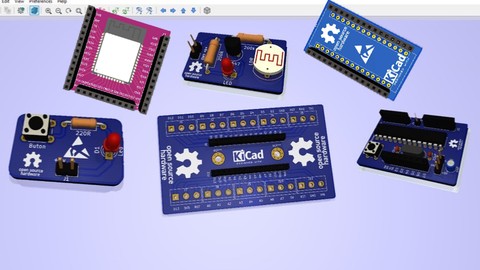
Quick Start to PCB Designs with KiCad
Quick Start to PCB Designs with KiCad, available at $19.99, has an average rating of 5, with 44 lectures, based on 2 reviews, and has 122 subscribers.
You will learn about They will be able to design their own PCB cards and learn the logic of PCB card design. KiCad Gerber 2 Layer Design This course is ideal for individuals who are Engineering students , teachers and anyone who wants to design their own card. It is particularly useful for Engineering students , teachers and anyone who wants to design their own card.
Enroll now: Quick Start to PCB Designs with KiCad
Summary
Title: Quick Start to PCB Designs with KiCad
Price: $19.99
Average Rating: 5
Number of Lectures: 44
Number of Published Lectures: 44
Number of Curriculum Items: 44
Number of Published Curriculum Objects: 44
Original Price: $19.99
Quality Status: approved
Status: Live
What You Will Learn
- They will be able to design their own PCB cards and learn the logic of PCB card design.
- KiCad
- Gerber
- 2 Layer Design
Who Should Attend
- Engineering students , teachers and anyone who wants to design their own card.
Target Audiences
- Engineering students , teachers and anyone who wants to design their own card.
Our course starts with the installation of the program. We design our PCB boards with basic electronic circuits. With these design schemes, we can design the card in the size we want by using the KiCad program.
The KiCad program has been presented to us as a free program. Thanks to its easy and understandable interface, it makes designers comfortable to use.
By following our course, you can learn a new program and contribute to your personal development.
If you are tired of ready-made projects, if you want to design your own PCB board, this course is for you!
Note:Our course has been prepared by using AI technology. KiCad is a constantly updated program. This course was shot with KiCad 5. In this course, you will be able to quickly learn prototyping without going into too much detail. The important thing is to understand the design logic. The interfaces do not change too much and you can easily adapt to new updates.
About KiCad
KiCad is an open source software suite for Electronic Design Automation (EDA). The programs handle Schematic Capture, and PCB Layout with Gerber output. The suite runs on Windows, Linux and macOS and is licensed under GNU GPL v3.
Mission Statement
The goal of the KiCad project is to provide the best possible cross platform electronics design application for professional electronics designers. Every effort is made to hide the complexity of advanced design features so that KiCad remains approachable by new and inexperienced users, but when determining the direction of the project and the priority of new features, the needs of professional users take precedence.
Project Governance
The KiCad project is governed by a technical committee made up of the members of the lead development team. Most decisions are made by a consensus of the technical committee. When a consensus cannot be reached the final decision is made by the project leader.
History
KiCad was first released in 1992 by its original author, Jean-Pierre Charras. It has been in continual development since then and is now managed by the KiCad Development Team.
The name of KiCad comes from the first letters of a company of Jean-Pierre Charras’ friend “Ki” being combined with “Cad”. But it now has no meaning other than being the name of the software suite. Mentioned by Jean-Pierre in an email.
More KiCad history, general information, and advancements can be found in Wayne’s 2015, 2016, 2017, 2018, 2019, 2020, and 2021 FOSDEM presentations.
Course Curriculum
Chapter 1: Beginning
Lecture 1: KiCad Installation 5.1.4_1. [Important]
Lecture 2: User Interface Overview
Lecture 3: Main Design Interface
Lecture 4: Schematic – Left Toolbar
Lecture 5: Schematic – Top Toolbar
Lecture 6: Schematic – Right Toolbar
Lecture 7: PCB- Left Toolbar
Lecture 8: PCB – Top Toolbar
Lecture 9: PCB – Right Toolbar
Chapter 2: Turn LED On and Off With Push Button
Lecture 1: Schematic Design
Lecture 2: PCB Design
Lecture 3: Gerber Output
Lecture 4: Gerber Check on Website
Chapter 3: Led Light Circuit with LDR
Lecture 1: Introduction of the Circuit to be Designed
Lecture 2: Schematic LDR
Lecture 3: Assign Footprint
Lecture 4: PCB Design LDR
Lecture 5: Gerber Output
Chapter 4: Nano Shield Design
Lecture 1: Schematic Nano
Lecture 2: PCB Nano
Lecture 3: Naming Procedures
Lecture 4: Logo Placement
Lecture 5: Gerber Output
Chapter 5: Mini Uno Board Design with ATmega328P
Lecture 1: Introduction of the Circuit
Lecture 2: Personal Development Advice
Lecture 3: Schematic Design
Lecture 4: Footprint Assignment
Lecture 5: Component Placement
Lecture 6: PCB Connection
Lecture 7: Naming and Gerber Output
Lecture 8: Gerber View Mini Uno
Chapter 6: BONUS
Lecture 1: How to Order Professional PCB?
Chapter 7: BONUS – ESP32 Shield Design
Lecture 1: How to Download Ready Library?
Lecture 2: Creating a Project
Lecture 3: Adding Downloaded Libraries to KiCad
Lecture 4: Schematic Design
Lecture 5: PCB Design
Lecture 6: ESP32 3D Model Upload
Lecture 7: Gerber Output & View
Chapter 8: BONUS – Basic Nano Shield Design
Lecture 1: Schematic – 1
Lecture 2: Schematic – 2
Lecture 3: PCB – 1
Lecture 4: PCB – 2
Lecture 5: Gerber Output & View
Instructors
-
Academix Education
AR | VR | MR | STEM | Hardware | Software
Rating Distribution
- 1 stars: 0 votes
- 2 stars: 0 votes
- 3 stars: 0 votes
- 4 stars: 0 votes
- 5 stars: 2 votes
Frequently Asked Questions
How long do I have access to the course materials?
You can view and review the lecture materials indefinitely, like an on-demand channel.
Can I take my courses with me wherever I go?
Definitely! If you have an internet connection, courses on Udemy are available on any device at any time. If you don’t have an internet connection, some instructors also let their students download course lectures. That’s up to the instructor though, so make sure you get on their good side!
You may also like
- Top 10 Financial Technology Courses to Learn in December 2024
- Top 10 Agile Methodologies Courses to Learn in December 2024
- Top 10 Project Management Courses to Learn in December 2024
- Top 10 Leadership Skills Courses to Learn in December 2024
- Top 10 Public Speaking Courses to Learn in December 2024
- Top 10 Affiliate Marketing Courses to Learn in December 2024
- Top 10 Email Marketing Courses to Learn in December 2024
- Top 10 Social Media Management Courses to Learn in December 2024
- Top 10 SEO Optimization Courses to Learn in December 2024
- Top 10 Content Creation Courses to Learn in December 2024
- Top 10 Game Development Courses to Learn in December 2024
- Top 10 Software Testing Courses to Learn in December 2024
- Top 10 Big Data Courses to Learn in December 2024
- Top 10 Internet Of Things Courses to Learn in December 2024
- Top 10 Quantum Computing Courses to Learn in December 2024
- Top 10 Cloud Computing Courses to Learn in December 2024
- Top 10 3d Modeling Courses to Learn in December 2024
- Top 10 Mobile App Development Courses to Learn in December 2024
- Top 10 Graphic Design Courses to Learn in December 2024
- Top 10 Videography Courses to Learn in December 2024






















